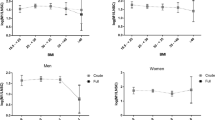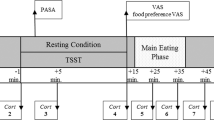Abstract
OBJECTIVE: Central obesity is associated with disturbances of hypothalamic–pituitary–adrenocortical (HPA) axis function. We investigated whether central adiposity indexed by waist/hip ratio is related to cortisol responses to waking and other measures of salivary cortisol over the working day.
PARTICIPANTS: In total, 89 men and 83 women aged 47–59 y recruited from the British civil service. All were members of the Whitehall II epidemiological cohort.
METHODS: Saliva samples were collected on waking, 30 min later, and then at 2-h intervals from 0800–0830 to 2200–2230. A strict procedure for excluding individuals who did not adhere to the sampling schedule was applied.
RESULTS: Waist/hip ratio in men was positively correlated with the cortisol response to waking (30 min—waking value) after adjusting for age, socioeconomic position, smoking status, alcohol consumption, time of waking, and cortisol level on waking (r=0.29, P=0.009). The cortisol response to waking was negatively related to high-density lipoprotein (HDL) cholesterol (r=−0.25) and positively with total/HDL cholesterol ratio (r=0.25). Associations between the decline in cortisol over the day and waist/hip ratio, HDL cholesterol and total/HDL cholesterol ratios were also significant. No associations were significant in women, and body mass index was unrelated to cortisol.
CONCLUSIONS: The cortisol response to waking is a dynamic indicator of HPA function that has previously been related to chronic psychological stress. These results confirm a recent Swedish study, and indicate that cortisol responses to waking may be indicative of neuroendocrine disturbance in central obesity.
This is a preview of subscription content, access via your institution
Access options
Subscribe to this journal
Receive 12 print issues and online access
$259.00 per year
only $21.58 per issue
Buy this article
- Purchase on Springer Link
- Instant access to full article PDF
Prices may be subject to local taxes which are calculated during checkout

Similar content being viewed by others
References
Tauchmanova L, Rossi R, Biondi B, Pulcrano M, Nuzzo V, Palmieri EA, Fazio S, Lombardi G . Patients with subclinical Cushing's Syndrome due to adrenal adenoma have increased cardiovascular risk. J Clin Endocrinol Metab 2002; 87: 4872–4878.
Pasquali R, Ambrosi B, Armanini D, Cavagnini F, Uberti ED, Del Rio G et al. Cortisol and ACTH response to oral dexamethasone in obesity and effects of sex, body fat distribution, and dexamethasone concentrations: a dose–response study. J Clin Endocrinol Metab 2002; 87: 166–175.
Ljung T, Andersson B, Bengtsson BA, Bjorntorp P, Marin P . Inhibition of cortisol secretion by dexamethosone in relation to body fat distribution. Obes Res 1996; 4: 277–282.
Vicennati V, Pasquali R . Abnormalities of the hypothalamic–pituitary–adrenal axis in nondepressed women with abdominal obesity and relations with insulin resistance: evidence for a central and a peripheral alteration. J Clin Endocrinol Metab 2000; 85: 4093–4098.
Katz JR, Taylor NF, Goodrick S, Perry L, Yudkin JS, Coppack SW . Central obesity, depression and the hypothalamo-pituitary-adrenal axis in men and postmenopausal women. Int J Obes Relat Metab Disord 2000; 24: 246–251.
Strain GW, Zumoff B, Strain JJ, Levin J, Fukushima DK . Cortisol production in obesity. Metabolism 1980; 29: 980–985.
Lottenberg SA, Giannella-Neto D, Derendorf H, Rocha M, Bosco A, Carvalho SV, Moretti AE, Lerario AC, Wajchenberg BL . Effect of fat distribution on the pharmacokinetics of cortisol in obesity. Int J Clin Pharmacol Ther 1998; 36: 501–505.
Andrew R, Phillips DI, Walker BR . Obesity and gender influence cortisol secretion and metabolism in man. J Clin Endocrinol Metab 1998; 83: 1806–1809.
Stewart PM, Boulton A, Kumar S, Clark PM, Shackleton CH . Cortisol metabolism in human obesity: impaired cortisone → cortisol conversion in subjects with central adiposity. J Clin Endocrinol Metab 1999; 84: 1022–1027.
Bjorntorp P . Do stress reactions cause abdominal obesity and comorbidities? Obes Rev 2001; 2: 73–86.
Rosmond R . Stress induced disturbances of the HPA axis: a pathway to Type 2 diabetes? Med Sci Monit 2003; 9: RA35–RA39.
Marin P, Darin N, Amemiya T, Anderssen B, Jern S, Bjorntorp P . Cortisol secretion in relation to body fat distribution in obese premenopausal women. Metabolism 1992; 41: 882–886.
Marniemi J, Kronholm E, Aunola S, Toikka T, Mattlar CE, Koskenvuo M, Ronnemaa T . Visceral fat and psychosocial stress in identical twins discordant for obesity. J Intern Med 2002; 251: 35–43.
Ljung T, Holm G, Friberg P, Andersson B, Bengtsson BA, Svensson J, Dallman M, McEwen B, Bjorntorp P . The activity of the hypothalamic–pituitary–adrenal axis and the sympathetic nervous system in relation to waist/hip circumference ratio in men. Obes Res 2000; 8: 487–495.
Phillips DI, Walker BR, Reynolds RM, Flanagan DE, Wood PJ, Osmond C, Barker DJ, Whorwood CB . Low birth weight predicts elevated plasma cortisol concentrations in adults from 3 populations. Hypertension 2000; 35: 1301–1306.
Phillips DI, Barker DJ, Fall CH, Seckl JR, Whorwood CB, Wood PJ, Walker BR . Elevated plasma cortisol concentrations: a link between low birth weight and the insulin resistance syndrome? J Clin Endocrinol Metab 1998; 83: 757–760.
Rask E, Walker BR, Soderberg S, Livingstone DE, Eliasson M, Johnson O, Andrew R, Olsson T . Tissue-specific changes in peripheral cortisol metabolism in obese women: increased adipose 11beta-hydroxysteroid dehydrogenase type 1 activity. J Clin Endocrinol Metab 2002; 87: 3330–3336.
Ward AM, Fall CH, Stein CE, Kumaran K, Veena SR, Wood PJ, Syddall HE, Phillips DI . Cortisol and the metabolic syndrome in South Asians. Clin Endocrinol (Oxford) 2003; 58: 500–505.
Wüst S, Wolf J, Hellhammer DH, Federenko I, Schommer N, Kirschbaum C . The cortisol awakening response—normal values and confounds. Noise Health 2000; 7: 77–85.
Schulz P, Kirschbaum C, Pruessner J, Hellhammer D . Increased free cortisol secretion after awakening in chronically stressed individuals due to work overload. Stress Med 1998; 14: 91–97.
Kunz-Ebrecht SR, Kirschbaum C, Steptoe A . Work stress, socioeconomic status, and neuroendocrine activation over the working day. Soc Sci Med 2004; 58: 1523–1530.
Pruessner M, Hellhammer DH, Pruessner JC, Lupien SJ . Self-reported depressive symptoms and stress levels in healthy young men: associations with the cortisol response to awakening. Psychosom Med 2003; 65: 92–99.
Bhagwagar Z, Hafizi S, Cowen PJ . Increase in concentration of waking salivary cortisol in recovered patients with depression. Am J Psychiatry 2003; 160: 1890–1891.
Kunz-Ebrecht SR, Kirschbaum C, Marmot M, Steptoe A . Differences in cortisol awakening response on work days and weekends in women and men from the Whitehall II cohort. Psychoneuroendocrinology 2004; 29: 516–528.
Pruessner JC, Hellhammer DH, Kirschbaum C . Burnout, perceived stress, and cortisol responses to awakening. Psychosom Med 1999; 61: 197–204.
Wallerius S, Rosmond R, Ljung T, Holm G, Bjorntorp P . Rise in morning saliva cortisol is associated with abdominal obesity in men: a preliminary report. J Endocrinol Invest 2003; 26: 616–619.
Kudielka BM, Broderick JE, Kirschbaum C . Compliance with saliva sampling protocols: electronic monitoring reveals invalid cortisol daytime profiles in noncompliant subjects. Psychosom Med 2003; 65: 313–319.
Steptoe A, Feldman PM, Kunz S, Owen N, Willemsen G, Marmot M . Stress responsivity and socioeconomic status: a mechanism for increased cardiovascular disease risk? Euro Heart J 2002; 23: 1757–1763.
Steptoe A, Kunz-Ebrecht S, Owen N, Feldman PJ, Willemsen G, Kirschbaum C, Marmot M . Socioeconomic status and stress-related biological responses over the working day. Psychosom Med 2003; 65: 461–470.
Marmot MG, Davey Smith G, Stansfeld S, Patel C, North F, Head J, White I, Brunner E, Feeney A . Health inequalities among British civil servants: the Whitehall II study. Lancet 1991; 337: 1387–1393.
Dressendörfer RA, Kirschbaum C, Rohde W, Stahl F, Strasburger CJ . Synthesis of a cortisol-biotin conjugate and evaluation as a tracer in an immunoassay for salivary cortisol measurement. J Steroid Biochem Mol Biol 1992; 43: 683–692.
Kudielka BM, Kirschbaum C . Awakening cortisol responses are influenced by health status and awakening time but not by menstrual cycle phase. Psychoneuroendocrinology 2003; 28: 35–47.
Edwards S, Evans P, Hucklebridge F, Clow A . Association between time of awakening and diurnal cortisol secretory activity. Psychoneuroendocrinology 2001; 26: 613–622.
Murphy BEP . Corticosteroid-binding globulin (transcortin). In: Fink G (ed) Encyclopedia of stress, Vol 1 Academic Press: San Diego; 2000. 547–556.
Rosmond R, Dallman MF, Bjorntorp P . Stress-related cortisol secretion in men: relationships with abdominal obesity and endocrine, metabolic and hemodynamic abnormalities. J Clin Endocrinol Metab 1998; 83: 1853–1859.
Stone AA, Schwartz JE, Smyth J, Kirschbaum C, Cohen S, Hellhammer D, Grossman S . Individual differences in the diurnal cycle of salivary free cortisol: a replication of flattened cycles for some individuals. Psychoneuroendocrinology 2001; 26: 295–306.
Ice GH, Katz-Stein A, Himes J, Kane RL . Diurnal cycles of salivary cortisol in older adults. Psychoneuroendocrinology 2004; 29: 355–370.
Brunner EJ, Hemingway H, Walker BR, Page M, Clarke P, Juneja M, Shipley MJ, Kumari M, Andrew R, Seckl JR, Papadopoulos A, Checkley S, Rumley A, Lowe GD, Stansfeld SA, Marmot MG . Adrenocortical, autonomic, and inflammatory causes of the metabolic syndrome: nested case–control study. Circulation 2002; 106: 2659–2665.
Bjorntorp P . The regulation of adipose tissue distribution in humans. Int J Obes Relat Metab Disord 1996; 20: 291–302.
Epel ES, McEwen B, Seeman T, Matthews K, Castellazzo G, Brownell KD, Bell J, Ickovics JR . Stress and body shape: stress-induced cortisol secretion is consistently greater among women with central fat. Psychosom Med 2000; 62: 623–632.
Moyer AE, Rodin J, Grilo CM, Cummings N, Larson LM, Rebuffe-Scrive M . Stress-induced cortisol response and fat distribution in women. Obes Res 1994; 2: 255–261.
Epel EE, Moyer AE, Martin CD, Macary S, Cummings N, Rodin J, Rebuffe-Scrive M . Stress-induced cortisol, mood, and fat distribution in men. Obes Res 1999; 7: 9–15.
Spiegel K, Leproult R, Van Cauter E . Impact of sleep debt on metabolic and endocrine function. Lancet 1999; 354: 143–149.
Breuner CW, Orchinik M . Plasma binding proteins as mediators of corticosteroid action in vertebrates. J Endocrinol 2002; 175: 99–112.
Acknowledgements
This research was supported by the Medical Research Council, UK. We are grateful to Gonneke Willemsen, Pamela J Feldman, Natalie Owen and Bev Murray for their participation in data collection, and to Clemens Kirschbaum from the Technical University Dresden for analysing the cortisol samples.
Author information
Authors and Affiliations
Corresponding author
Rights and permissions
About this article
Cite this article
Steptoe, A., Kunz-Ebrecht, S., Brydon, L. et al. Central adiposity and cortisol responses to waking in middle-aged men and women. Int J Obes 28, 1168–1173 (2004). https://doi.org/10.1038/sj.ijo.0802715
Received:
Revised:
Accepted:
Published:
Issue Date:
DOI: https://doi.org/10.1038/sj.ijo.0802715
Keywords
This article is cited by
-
Negative associations of morning serum cortisol levels with obesity: the Henan rural cohort study
Journal of Endocrinological Investigation (2021)
-
Evidence for disruption of diurnal salivary cortisol rhythm in childhood obesity: relationships with anthropometry, puberty and physical activity
BMC Pediatrics (2020)
-
Long-term glucocorticoid concentrations as a risk factor for childhood obesity and adverse body-fat distribution
International Journal of Obesity (2016)
-
Cortisol and ghrelin concentrations following a cold pressor stress test in overweight individuals with and without night eating
International Journal of Obesity (2013)
-
Stress and Abdominal Fat: Preliminary Evidence of Moderation by the Cortisol Awakening Response in Hispanic Peripubertal Girls
Obesity (2011)



